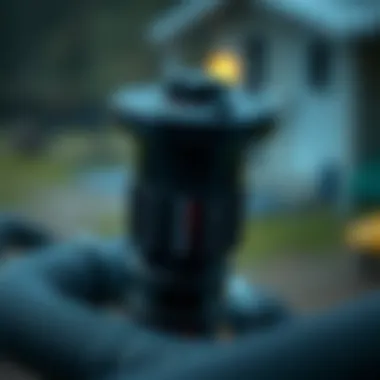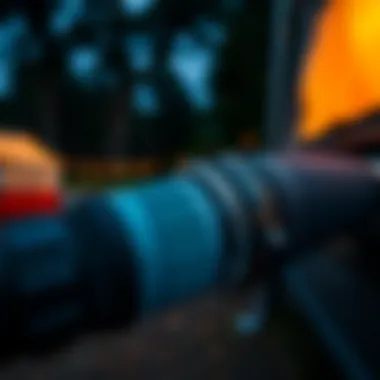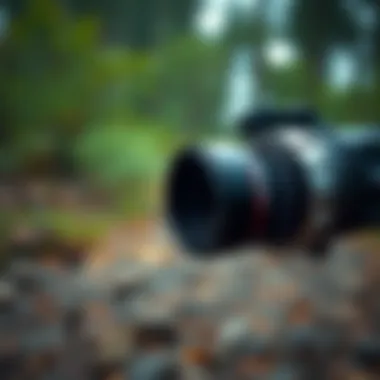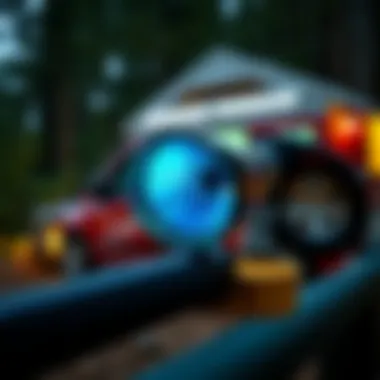In-Depth Guide to Camper Hose Water Filters


Intro
In the realm of outdoor adventures, ensuring access to clean water can sometimes take a back seat to more urgent concerns like setting up camp or starting a fire. Yet, having safe water is as essential as having a sturdy tent or a reliable camping stove. Camper hose water filters provide an efficient solution for those on the go, transforming potentially problematic water sources into safe drinking water, whether you are by a lake, river, or even a municipal supply.
The first thing to grasp is that not all filters are created equal. Some are designed for specific environmental situations, while others come with a universal appeal. In this article, we will navigate through the intricacies of camper hose water filters, including their working mechanics, various types available, and how to choose one that best fits your needs. Additionally, we’ll delve into the methodologies behind evaluating product quality, expert recommendations, and tips for maintaining these essential tools. By the end of this journey, you will have a well-rounded view of how to ensure clean hydration for your adventures in the great outdoors.
Preface to Camper Hose Water Filters
Water—it's an indispensable necessity, especially when you’re out in the wild, soaking in nature's beauty. But before gulping down that refreshing sip, have you considered what’s coursing through those pipes? Camper hose water filters act as a knight in shining armor, standing guard over your hydration. They’re not just another piece of gear; they’re a vital element in ensuring the safety and purity of the water you drink while adventuring.
Purpose and Significance
The primary aim of camper hose water filters is simple yet crucial: to remove impurities from the water being supplied to your camper. You can encounter a host of contaminants—sediments, bacteria, or even unpleasant tastes—when drawing water from natural sources or even from a public water supply. This is where the significance of these filters comes in.
Investing in a quality water filter means investing in your health and comfort. It helps to minimize the risk of waterborne illnesses that could otherwise derail a weekend getaway. Furthermore, these filters play an essential role in enhancing water quality, which can significantly elevate your camping experience. It’s not just about drinking water—clean filtered water can also make a big difference in preparing meals, cleaning, and even fueling your recreational activities like washing dishes or cleaning equipment.
Common Applications in Outdoor Settings
Camper hose water filters aren’t one-size-fits-all. They find themselves being implemented in a variety of settings, each tailored to meet specific needs. Here are a few common applications:
- Camping: Whether you're wild camping out in the woods or parked at a campsite, having clean water is vital.
- RV Living: Full-time RVers appreciate the convenience of a mounted filter system that guarantees continual access to safe water.
- Boating: Sailors and boat enthusiasts often need water purification systems aboard to ensure drinking water stays uncontaminated.
- Emergency Supplies: In scenarios where water quality may be compromised—like natural disasters—having a camper hose water filter can mean life or death.
"Access to clean drinking water is a fundamental aspect of any safe outdoor experience."
In essence, the application of camper hose water filters ranges far and wide, tailored to fit the demands of various outdoor enthusiasts. From road trips across national parks to weekend escapes at the lake, these filters ensure that your adventure is not only enjoyable but also safe.
Mechanics of Water Filtration
The mechanics behind water filtration play a crucial role in ensuring the water you consume outdoors is free from contaminants. Understanding how these systems function allows users to make informed decisions, ensuring not just hydration but also health. In many outdoor settings, the sources of water can be unpredictable, and the integrity of that water is paramount for an enjoyable experience.
Understanding Filtration Technologies
Water filtration technologies come in many forms. Each employs different techniques to purify water, often tailored to specific contaminants. It can be quite the eye-opener when you realize the wide variety of choices available. Here are a few of the most common types of filtration technologies:


- Activated Carbon: This type filters out impurities via the principle of adsorption, where contaminants stick to the surface of the carbon granules. It's popular for removing chlorine and improving taste, making it a go-to for many campers.
- Ultraviolet (UV) Systems: Utilizing light to disinfect water, these systems are effective in eradicating bacteria, viruses, and other microorganisms. They're particularly useful in areas where the biological safety of water is a concern.
- Reverse Osmosis: This filtration technique forces water through a semi-permeable membrane that separates impurities from clean water. While highly effective, it can be somewhat slow and often requires a pressurized system.
Knowing which technology to choose is greatly influenced by the specific needs of your outdoor adventures and the water quality you'll encounter.
Comparative Effectiveness of Filters
Each filtration system comes with its own set of strengths and weaknesses, which are worth considering for safe hydration. Below, I break down the effectiveness of three common types of filters:
Activated Carbon
Activated Carbon works wonders for removing contaminants like chlorine and sediment. Its ability to significantly improve the flavor and smell of water makes it very popular among outdoor enthusiasts. However, it's more effective for some contaminants than others. It won't remove heavy metals or salts, which are sometimes present in ground or surface water. When it comes to cost-effectiveness and ease of use, many users find it to be a solid choice for regular camping trips. In other words, it's simple, yet impactful.
Ultraviolet (UV) Systems
Ultraviolet systems are known for their efficient elimination of bacteria and viruses. This technology doesn't involve any chemicals, giving it an edge from a health perspective. However, it's essential to have clear water for UV systems to function well, as turbidity can hinder effectiveness. One downside is that UV filters often require electricity or batteries, which can be a potential limitation in remote areas. Nonetheless, for serious adventurers, the peace of mind that comes from UV filtration can be invaluable.
Reverse Osmosis
Reverse Osmosis is among the most thorough filtration methods available. It effectively removes a wide variety of pollutants, including salts, heavy metals, and many other dissolved substances. The primary drawback is the slow process of filtration, which can be frustrating when you're in a hurry. Moreover, it can waste a significant amount of water during the filtration process. Despite these challenges, when you require the purest possible water, Reverse Osmosis stands tall.
"Choosing the right filtration method depends not just on the water source, but on your overall needs and preferences during your adventures."
Types of Camper Hose Water Filters
When it comes to ensuring a clean drinking experience while on the road, camper hose water filters are a critical component for any outdoor enthusiast. Selecting the right type of filter can significantly impact the quality of water, the longevity of your equipment, and even your overall health during those off-the-grid getaways. Understanding the different kinds of filters available helps you make an informed decision based on your unique needs and challenges that may arise while you're making memories in the great outdoors.
Inline Water Filters
Inline water filters are like the unsung heroes of camper setups, often overlooked but immensely crucial. These filters are installed directly into the water supply line, allowing water to pass through them as it's being drawn into your camper. This filtering takes place seamlessly, eliminating contaminants from your water source before it even reaches your faucet.
One significant benefit of inline water filters is their effectiveness in reducing chlorine taste and odor, sediment, and other potential pollutants. Because they are typically compact, they fit snugly into most camper designs, ensuring space-saving solutions without compromising on performance. The installation process is generally straightforward—just a matter of detaching your current hose and replacing it with one that includes an inline filter.
Considerations for Inline Filters
- Maintenance: Inline filters need periodic checks. Depending on usage and water quality, the cartridge might require replacement every few months.
- Flow Rate: Some inline filters might impact water pressure. Be sure to choose a model designed for high flow rates if you have multiple taps.
- Filter Life: Consider how often you will use your camper and the local water quality. Occasional campers may find longer filter life acceptable, while frequent users might need quicker replacements.


Inline Filter vs. Point-of-Use Filter
At first glance, it might appear that inline filters and point-of-use filters serve similar functions, but they cater to distinct needs within the outdoor community. Point-of-use (POU) filters are typically installed at a single tap or fixture, like your kitchen sink, offering targeted filtration where you need it the most.
In contrast, inline filters serve as a whole-system-wide solution, filtering water as it flows into the camper. For those who prioritize versatility, inline filters can be immensely beneficial, as they don't require separate installations for each tap.
Pros and Cons
- Inline Filters:
- Point-of-Use Filters:
- Pros:
- Cons:
- Continuous filtration for all water sources in your camper.
- Easier installation in many cases.
- May reduce flow rates at high demand.
- Requires regular replacing of filter cartridges.
- Pros:
- Cons:
- Targeted filtration for better water quality at specific taps.
- Can often handle higher contaminant loads due to smaller filtration area.
- Only filters water at one location.
- More complex setup and installation.
Choosing between these two types depends on what you value in your camper setup: adaptability or specificity.
Portable Water Filtration Systems
Moving beyond the fixed installation realm, portable water filtration systems offer a flexible and convenient alternative for those who travel frequently or seek a minimalist approach to water safety. These systems are designed for ease of transport and can filter water directly from various sources, such as rivers, lakes, or outdoor faucets.
A notable advantage of these systems is their versatility; many models are compact, lightweight, and often come with their own storage containers, making them an easy addition to your camping gear. Whether you're backpacking or simply navigating to a new campsite, you can fill your bottle, and it’s ready to drink!
Key Features of Portable Systems
- Filter Types: Some may utilize activated carbon, while others might cross the UV technology line. Assess your needs to choose the right type.
- Easy Maintenance: Many portable systems require minimal upkeep. A quick rinse can do wonders.
- Cost-Effective: The upfront investment can often be lower than fixed systems, especially if you’re not using your camper regularly.
Portable systems do come with caveats, such as requiring more time to filter larger amounts of water compared to inline models. However, if your adventures lead you to unpredictable water sources, the convenience these systems provide can be invaluable.


When it comes to camper hose water filters, choosing the right type can enhance not only the quality of your drinking water but also your overall camping experience. Think through your needs carefully, and you’ll be on your way to enjoying fresh, clean water during your adventures!
Installing a Camper Hose Water Filter
Installing a camper hose water filter is a significant step in ensuring you have clean and safe drinking water while enjoying the great outdoors. Apart from improving water quality, a proper installation can enhance the longevity of your filtering system and provide peace of mind during your trips. Knowing how to efficiently set up these filters allows campers to enjoy their adventures without worrying about the potential dangers of contaminated water from natural sources or even campsite spigots.
The future of outdoor adventures necessitates a deeper understanding of the proper installation of these filters. Equipping yourself with this knowledge empowers you to tackle water safety head-on.
Selecting the Right Location
Location, location, location—this adage holds true for many life aspects, including the installation of your water filter. Finding the ideal spot to set up your camper hose water filter can make a world of difference.
First off, think about practicalities. The chosen location must be easily accessible, allowing for swift connection and disconnection when setting up your camper. Additionally, consider the environmental conditions. Avoid direct exposure to the burning sun or heavy precipitation, as both can affect the performance of your filter over time. Ideally, the filter should be placed close to the water source—this minimizes the need for long lengths of hose and thus reduces resistance in the system, leading to a more efficient flow rate.
Moreover, ensure that the area is clean and away from potential contaminants such as dirt, oil, or chemicals. Remember, the last thing you want is for outside elements to taint your pristine water supply.
Step-by-Step Installation Process
Setting up your camper hose water filter might seem like a daunting task; however, breaking it down into manageable steps can simplify the process tremendously. Follow these actionable steps for a successful installation:
- Gather Necessary Tools and Equipment: Before starting, ensure you have all required tools on hand. This typically includes the filter itself, hoses, a wrench, and any mounting brackets if needed.
- Turn Off the Water Supply: For safety, ensure that any water supply you plan to connect your filter to is turned off before you begin.
- Connect the Filter to the Hose: Attach one end of the hose to the appropriate inlet on the filter. Make sure the connection is secure to prevent leaks. This is where you might say, "A stitch in time saves nine!"—taking care now can save a headache later.
- Secure the Other End: Connect the opposite end of the hose to your water supply. Again, ensure a tight fit, as loose connections can lead to unwanted spills or drops in pressure.
- Check for Leaks: After hooking everything up, turn the supply back on to test for leaks. If any are found, turn off the supply and tighten the connections.
- Flush the System: It’s a good idea to run water through the filter for a few minutes before consumption. This helps eliminate any debris or carbon dust from the filter media and ensures optimal taste from the start.
- Regular Checks Moving Forward: Leading up to your adventures, make it a habit to check the system periodically for signs of wear or leaks, ensuring a smooth experience while you enjoy the great outdoors.
Proper installation is only as good as its execution. Keeping a close eye on every step can make a significant difference in your camping experience.
Taking the time to understand and carefully execute the installation of your camper hose water filter is invaluable. Being meticulous with these steps ensures your outdoor hydration will meet your expectations, allowing you to savor every moment without unexpected interruptions.
Maintenance Best Practices
Regular maintenance is not just a recommendation when it comes to camper hose water filters; it's essential for ensuring the purity and safety of your water supply. Proper care of your filtration system can extend its lifespan, enhance its efficiency, and ultimately, save you money in the long run. When setting out on your adventures, knowing that your water is clean and safe to drink should not be a matter of luck but a result of conscientious upkeep.
Regular Inspection and Cleaning
The first step in maintaining your camper hose water filter is to conduct regular inspections. Much like checking the oil in your car or examining the tires, inspecting your water filter should become a routine part of your camping mission checklist.
- Why Inspect?
Filters can accumulate contaminants over time. Checking for any wear and tear, blockages, or unexpected changes in water quality is key. You wouldn’t want to be out in the wild with a filter that has lost its effectiveness due to neglect. - Cleaning Process:
Depending on the type of filter you have, the cleaning process may vary. Inline filters often require simple rinsing with clean water to remove debris. For more complex systems, following the manufacturer’s specific cleaning guidelines is crucial.
A compatible method is to soak the filter in a mix of white vinegar and water. It’s a natural way to break down deposits while being environmentally friendly
cleaning_solution = mix(1_cup_vinegar, 4_cups_water)



